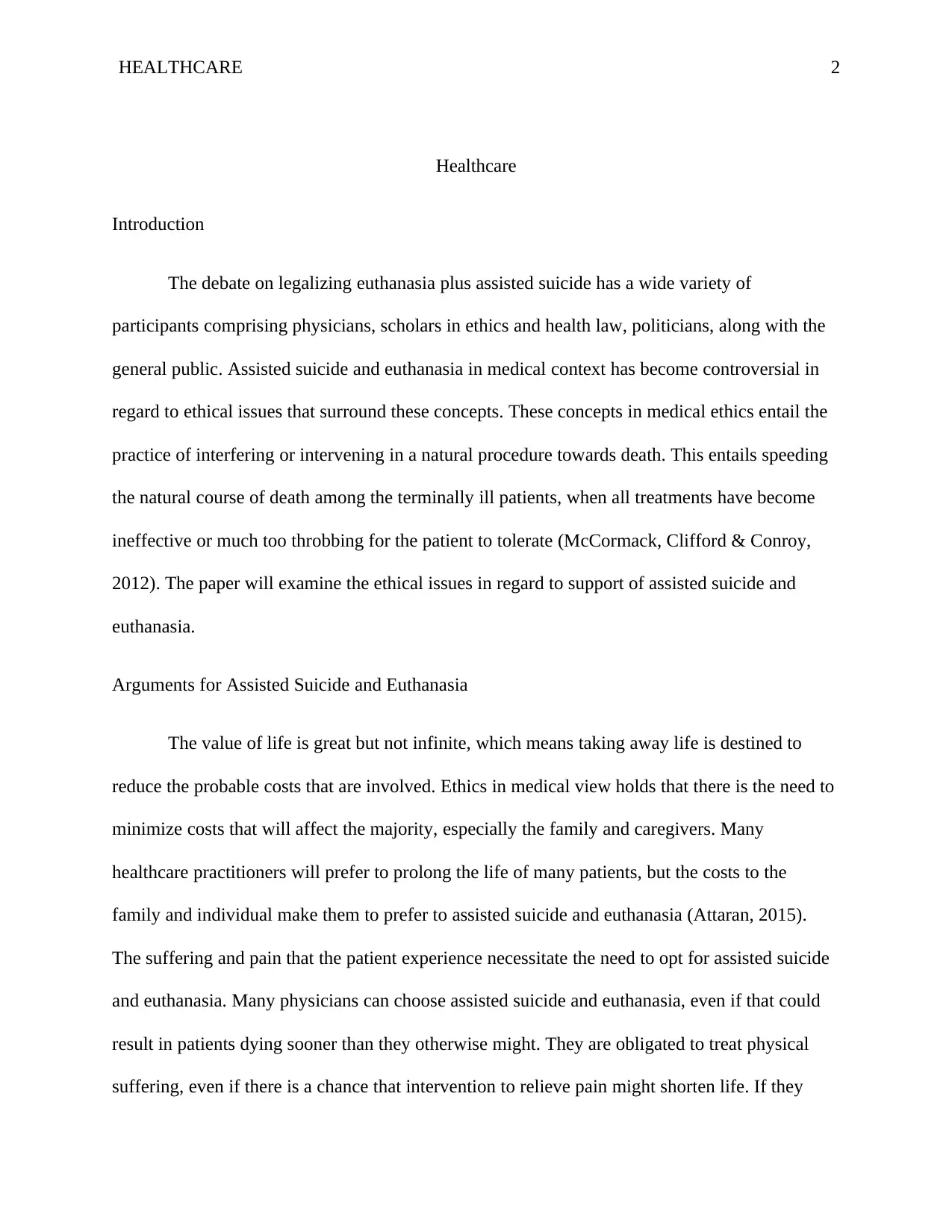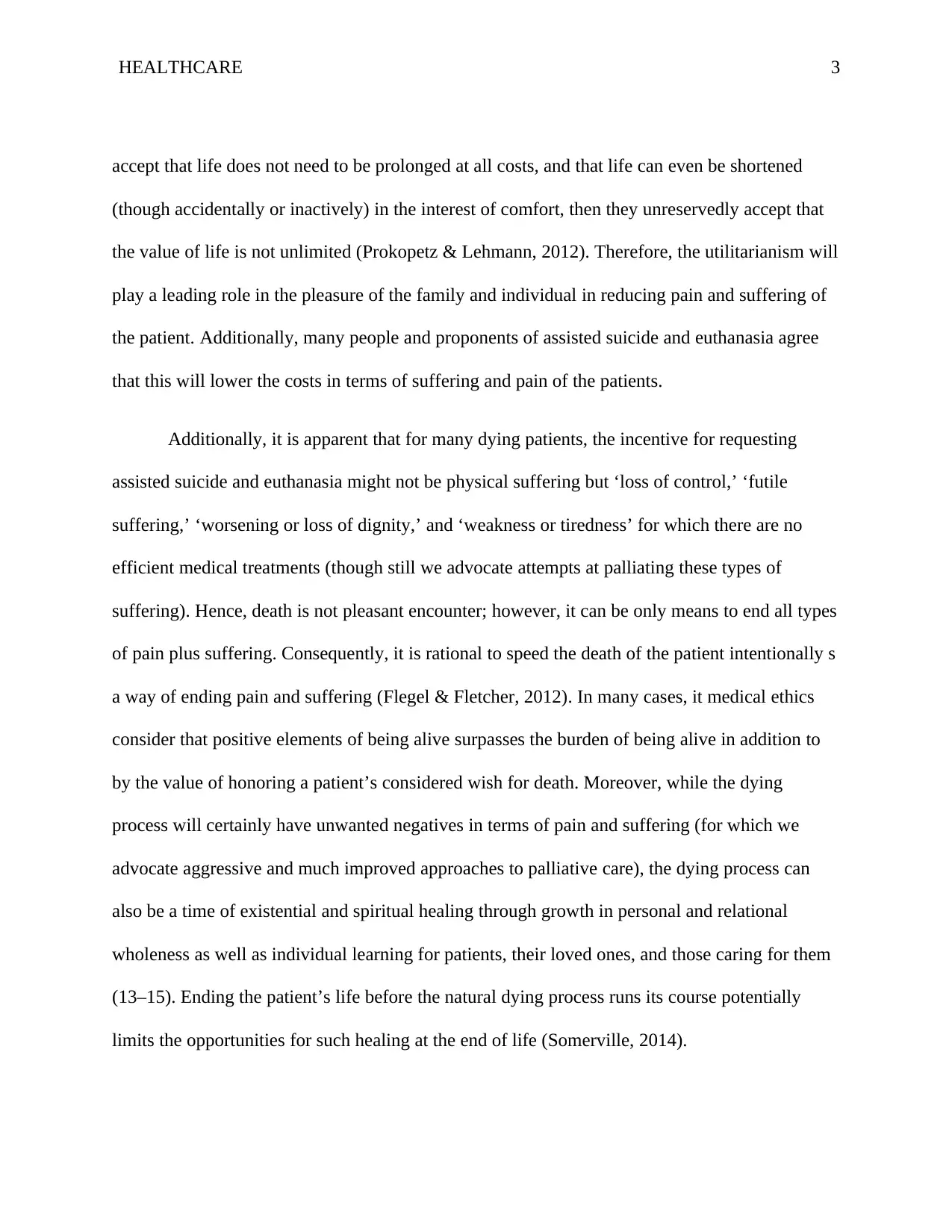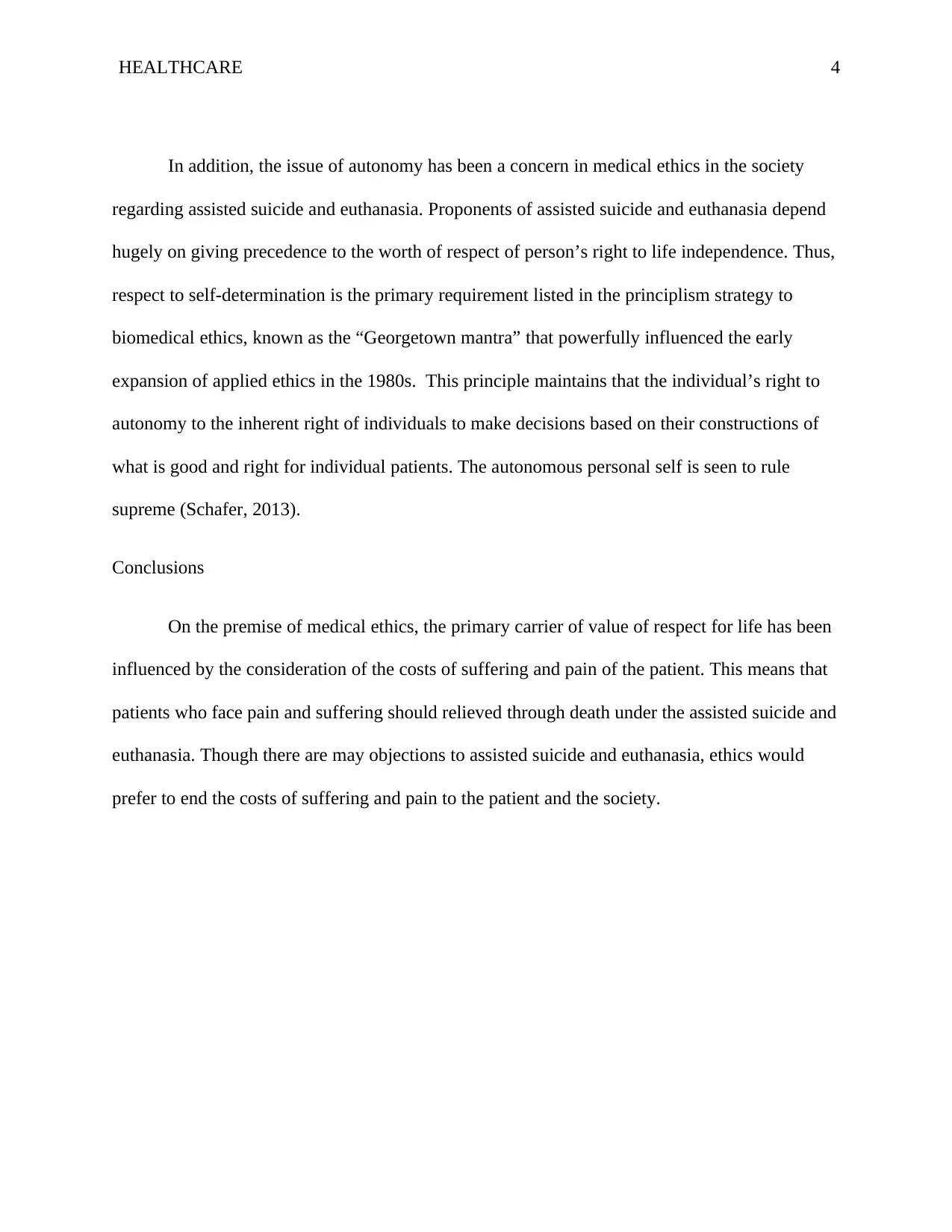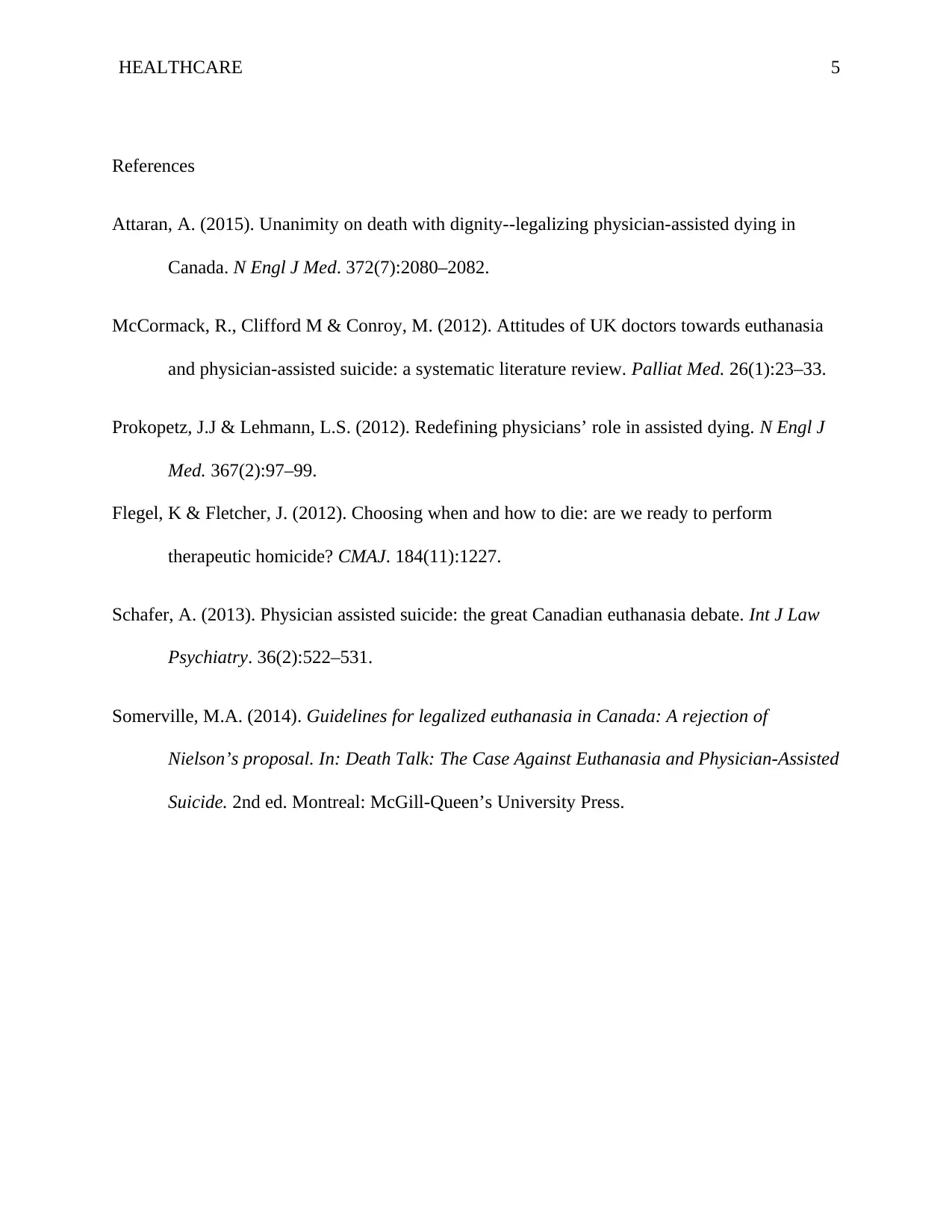Ethical Debate: Assisted Suicide and Euthanasia in Medical Context
VerifiedAdded on 2022/12/29
|5
|1087
|70
Presentation
AI Summary
This presentation provides an in-depth analysis of the ethical issues surrounding assisted suicide and euthanasia within the healthcare context. It begins with an introduction defining the terms and highlighting the controversy, involving physicians, ethicists, and the public. The presentation then outlines the arguments in favor of assisted suicide and euthanasia, focusing on the concepts of minimizing suffering and costs, respecting patient autonomy, and the limitations of medical treatments. The discussion covers the utilitarian perspective, considering the reduction of pain and suffering for patients and their families, and emphasizes the importance of patient autonomy and self-determination in end-of-life decisions. The presentation concludes by summarizing the ethical considerations and encourages further exploration of the complex issues involved, including the value of life, the role of palliative care, and the impact on healthcare practices.

Running Head: HEALTHCARE
Healthcare
Name
Institution
Healthcare
Name
Institution
Paraphrase This Document
Need a fresh take? Get an instant paraphrase of this document with our AI Paraphraser

HEALTHCARE 2
Healthcare
Introduction
The debate on legalizing euthanasia plus assisted suicide has a wide variety of
participants comprising physicians, scholars in ethics and health law, politicians, along with the
general public. Assisted suicide and euthanasia in medical context has become controversial in
regard to ethical issues that surround these concepts. These concepts in medical ethics entail the
practice of interfering or intervening in a natural procedure towards death. This entails speeding
the natural course of death among the terminally ill patients, when all treatments have become
ineffective or much too throbbing for the patient to tolerate (McCormack, Clifford & Conroy,
2012). The paper will examine the ethical issues in regard to support of assisted suicide and
euthanasia.
Arguments for Assisted Suicide and Euthanasia
The value of life is great but not infinite, which means taking away life is destined to
reduce the probable costs that are involved. Ethics in medical view holds that there is the need to
minimize costs that will affect the majority, especially the family and caregivers. Many
healthcare practitioners will prefer to prolong the life of many patients, but the costs to the
family and individual make them to prefer to assisted suicide and euthanasia (Attaran, 2015).
The suffering and pain that the patient experience necessitate the need to opt for assisted suicide
and euthanasia. Many physicians can choose assisted suicide and euthanasia, even if that could
result in patients dying sooner than they otherwise might. They are obligated to treat physical
suffering, even if there is a chance that intervention to relieve pain might shorten life. If they
Healthcare
Introduction
The debate on legalizing euthanasia plus assisted suicide has a wide variety of
participants comprising physicians, scholars in ethics and health law, politicians, along with the
general public. Assisted suicide and euthanasia in medical context has become controversial in
regard to ethical issues that surround these concepts. These concepts in medical ethics entail the
practice of interfering or intervening in a natural procedure towards death. This entails speeding
the natural course of death among the terminally ill patients, when all treatments have become
ineffective or much too throbbing for the patient to tolerate (McCormack, Clifford & Conroy,
2012). The paper will examine the ethical issues in regard to support of assisted suicide and
euthanasia.
Arguments for Assisted Suicide and Euthanasia
The value of life is great but not infinite, which means taking away life is destined to
reduce the probable costs that are involved. Ethics in medical view holds that there is the need to
minimize costs that will affect the majority, especially the family and caregivers. Many
healthcare practitioners will prefer to prolong the life of many patients, but the costs to the
family and individual make them to prefer to assisted suicide and euthanasia (Attaran, 2015).
The suffering and pain that the patient experience necessitate the need to opt for assisted suicide
and euthanasia. Many physicians can choose assisted suicide and euthanasia, even if that could
result in patients dying sooner than they otherwise might. They are obligated to treat physical
suffering, even if there is a chance that intervention to relieve pain might shorten life. If they

HEALTHCARE 3
accept that life does not need to be prolonged at all costs, and that life can even be shortened
(though accidentally or inactively) in the interest of comfort, then they unreservedly accept that
the value of life is not unlimited (Prokopetz & Lehmann, 2012). Therefore, the utilitarianism will
play a leading role in the pleasure of the family and individual in reducing pain and suffering of
the patient. Additionally, many people and proponents of assisted suicide and euthanasia agree
that this will lower the costs in terms of suffering and pain of the patients.
Additionally, it is apparent that for many dying patients, the incentive for requesting
assisted suicide and euthanasia might not be physical suffering but ‘loss of control,’ ‘futile
suffering,’ ‘worsening or loss of dignity,’ and ‘weakness or tiredness’ for which there are no
efficient medical treatments (though still we advocate attempts at palliating these types of
suffering). Hence, death is not pleasant encounter; however, it can be only means to end all types
of pain plus suffering. Consequently, it is rational to speed the death of the patient intentionally s
a way of ending pain and suffering (Flegel & Fletcher, 2012). In many cases, it medical ethics
consider that positive elements of being alive surpasses the burden of being alive in addition to
by the value of honoring a patient’s considered wish for death. Moreover, while the dying
process will certainly have unwanted negatives in terms of pain and suffering (for which we
advocate aggressive and much improved approaches to palliative care), the dying process can
also be a time of existential and spiritual healing through growth in personal and relational
wholeness as well as individual learning for patients, their loved ones, and those caring for them
(13–15). Ending the patient’s life before the natural dying process runs its course potentially
limits the opportunities for such healing at the end of life (Somerville, 2014).
accept that life does not need to be prolonged at all costs, and that life can even be shortened
(though accidentally or inactively) in the interest of comfort, then they unreservedly accept that
the value of life is not unlimited (Prokopetz & Lehmann, 2012). Therefore, the utilitarianism will
play a leading role in the pleasure of the family and individual in reducing pain and suffering of
the patient. Additionally, many people and proponents of assisted suicide and euthanasia agree
that this will lower the costs in terms of suffering and pain of the patients.
Additionally, it is apparent that for many dying patients, the incentive for requesting
assisted suicide and euthanasia might not be physical suffering but ‘loss of control,’ ‘futile
suffering,’ ‘worsening or loss of dignity,’ and ‘weakness or tiredness’ for which there are no
efficient medical treatments (though still we advocate attempts at palliating these types of
suffering). Hence, death is not pleasant encounter; however, it can be only means to end all types
of pain plus suffering. Consequently, it is rational to speed the death of the patient intentionally s
a way of ending pain and suffering (Flegel & Fletcher, 2012). In many cases, it medical ethics
consider that positive elements of being alive surpasses the burden of being alive in addition to
by the value of honoring a patient’s considered wish for death. Moreover, while the dying
process will certainly have unwanted negatives in terms of pain and suffering (for which we
advocate aggressive and much improved approaches to palliative care), the dying process can
also be a time of existential and spiritual healing through growth in personal and relational
wholeness as well as individual learning for patients, their loved ones, and those caring for them
(13–15). Ending the patient’s life before the natural dying process runs its course potentially
limits the opportunities for such healing at the end of life (Somerville, 2014).
⊘ This is a preview!⊘
Do you want full access?
Subscribe today to unlock all pages.

Trusted by 1+ million students worldwide

HEALTHCARE 4
In addition, the issue of autonomy has been a concern in medical ethics in the society
regarding assisted suicide and euthanasia. Proponents of assisted suicide and euthanasia depend
hugely on giving precedence to the worth of respect of person’s right to life independence. Thus,
respect to self-determination is the primary requirement listed in the principlism strategy to
biomedical ethics, known as the “Georgetown mantra” that powerfully influenced the early
expansion of applied ethics in the 1980s. This principle maintains that the individual’s right to
autonomy to the inherent right of individuals to make decisions based on their constructions of
what is good and right for individual patients. The autonomous personal self is seen to rule
supreme (Schafer, 2013).
Conclusions
On the premise of medical ethics, the primary carrier of value of respect for life has been
influenced by the consideration of the costs of suffering and pain of the patient. This means that
patients who face pain and suffering should relieved through death under the assisted suicide and
euthanasia. Though there are may objections to assisted suicide and euthanasia, ethics would
prefer to end the costs of suffering and pain to the patient and the society.
In addition, the issue of autonomy has been a concern in medical ethics in the society
regarding assisted suicide and euthanasia. Proponents of assisted suicide and euthanasia depend
hugely on giving precedence to the worth of respect of person’s right to life independence. Thus,
respect to self-determination is the primary requirement listed in the principlism strategy to
biomedical ethics, known as the “Georgetown mantra” that powerfully influenced the early
expansion of applied ethics in the 1980s. This principle maintains that the individual’s right to
autonomy to the inherent right of individuals to make decisions based on their constructions of
what is good and right for individual patients. The autonomous personal self is seen to rule
supreme (Schafer, 2013).
Conclusions
On the premise of medical ethics, the primary carrier of value of respect for life has been
influenced by the consideration of the costs of suffering and pain of the patient. This means that
patients who face pain and suffering should relieved through death under the assisted suicide and
euthanasia. Though there are may objections to assisted suicide and euthanasia, ethics would
prefer to end the costs of suffering and pain to the patient and the society.
Paraphrase This Document
Need a fresh take? Get an instant paraphrase of this document with our AI Paraphraser

HEALTHCARE 5
References
Attaran, A. (2015). Unanimity on death with dignity--legalizing physician-assisted dying in
Canada. N Engl J Med. 372(7):2080–2082.
McCormack, R., Clifford M & Conroy, M. (2012). Attitudes of UK doctors towards euthanasia
and physician-assisted suicide: a systematic literature review. Palliat Med. 26(1):23–33.
Prokopetz, J.J & Lehmann, L.S. (2012). Redefining physicians’ role in assisted dying. N Engl J
Med. 367(2):97–99.
Flegel, K & Fletcher, J. (2012). Choosing when and how to die: are we ready to perform
therapeutic homicide? CMAJ. 184(11):1227.
Schafer, A. (2013). Physician assisted suicide: the great Canadian euthanasia debate. Int J Law
Psychiatry. 36(2):522–531.
Somerville, M.A. (2014). Guidelines for legalized euthanasia in Canada: A rejection of
Nielson’s proposal. In: Death Talk: The Case Against Euthanasia and Physician-Assisted
Suicide. 2nd ed. Montreal: McGill-Queen’s University Press.
References
Attaran, A. (2015). Unanimity on death with dignity--legalizing physician-assisted dying in
Canada. N Engl J Med. 372(7):2080–2082.
McCormack, R., Clifford M & Conroy, M. (2012). Attitudes of UK doctors towards euthanasia
and physician-assisted suicide: a systematic literature review. Palliat Med. 26(1):23–33.
Prokopetz, J.J & Lehmann, L.S. (2012). Redefining physicians’ role in assisted dying. N Engl J
Med. 367(2):97–99.
Flegel, K & Fletcher, J. (2012). Choosing when and how to die: are we ready to perform
therapeutic homicide? CMAJ. 184(11):1227.
Schafer, A. (2013). Physician assisted suicide: the great Canadian euthanasia debate. Int J Law
Psychiatry. 36(2):522–531.
Somerville, M.A. (2014). Guidelines for legalized euthanasia in Canada: A rejection of
Nielson’s proposal. In: Death Talk: The Case Against Euthanasia and Physician-Assisted
Suicide. 2nd ed. Montreal: McGill-Queen’s University Press.
1 out of 5
Related Documents
Your All-in-One AI-Powered Toolkit for Academic Success.
+13062052269
info@desklib.com
Available 24*7 on WhatsApp / Email
![[object Object]](/_next/static/media/star-bottom.7253800d.svg)
Unlock your academic potential
Copyright © 2020–2025 A2Z Services. All Rights Reserved. Developed and managed by ZUCOL.



